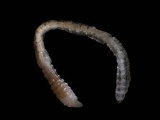
Capitella capitata
Encyclopedia
The Capitella capitata is a polychaete
worm
that grows up to 10 cm in length. It is often blood-red in colour. The species is sedentary and fragile, with a flexible body.
Capitella capitata occurs on muddy sand, gritty sand, fine sand or rich mud on the lower shore to sub-littoral. It may be found under pebbles or small stones, with the burrows at or near the surface of the sediment
.
It is an opportunistic species tolerant of stressful conditions, and often found in polluted waters (sewer discharges, hydrocarbons, metals ...) where it out-competes less tolerant species. A large abundance of C. capitata can be seen as an indication of polluted waters .
C. capitata is able to vary its reproductive strategy in accordance with its current environmental conditions. If local conditions are favorable, it can produce benthic larvae facilitating quick exploitation of local concentrations of organic matter. In contrast, C. capitata can produce planktonic larvae if there is a need to discover new habitats.
Polychaete
The Polychaeta or polychaetes are a class of annelid worms, generally marine. Each body segment has a pair of fleshy protrusions called parapodia that bear many bristles, called chaetae, which are made of chitin. Indeed, polychaetes are sometimes referred to as bristle worms. More than 10,000...
worm
Worm
The term worm refers to an obsolete taxon used by Carolus Linnaeus and Jean-Baptiste Lamarck for all non-arthropod invertebrate animals, and stems from the Old English word wyrm. Currently it is used to describe many different distantly-related animals that typically have a long cylindrical...
that grows up to 10 cm in length. It is often blood-red in colour. The species is sedentary and fragile, with a flexible body.
Capitella capitata occurs on muddy sand, gritty sand, fine sand or rich mud on the lower shore to sub-littoral. It may be found under pebbles or small stones, with the burrows at or near the surface of the sediment
Sediment
Sediment is naturally occurring material that is broken down by processes of weathering and erosion, and is subsequently transported by the action of fluids such as wind, water, or ice, and/or by the force of gravity acting on the particle itself....
.
It is an opportunistic species tolerant of stressful conditions, and often found in polluted waters (sewer discharges, hydrocarbons, metals ...) where it out-competes less tolerant species. A large abundance of C. capitata can be seen as an indication of polluted waters .
C. capitata is able to vary its reproductive strategy in accordance with its current environmental conditions. If local conditions are favorable, it can produce benthic larvae facilitating quick exploitation of local concentrations of organic matter. In contrast, C. capitata can produce planktonic larvae if there is a need to discover new habitats.

